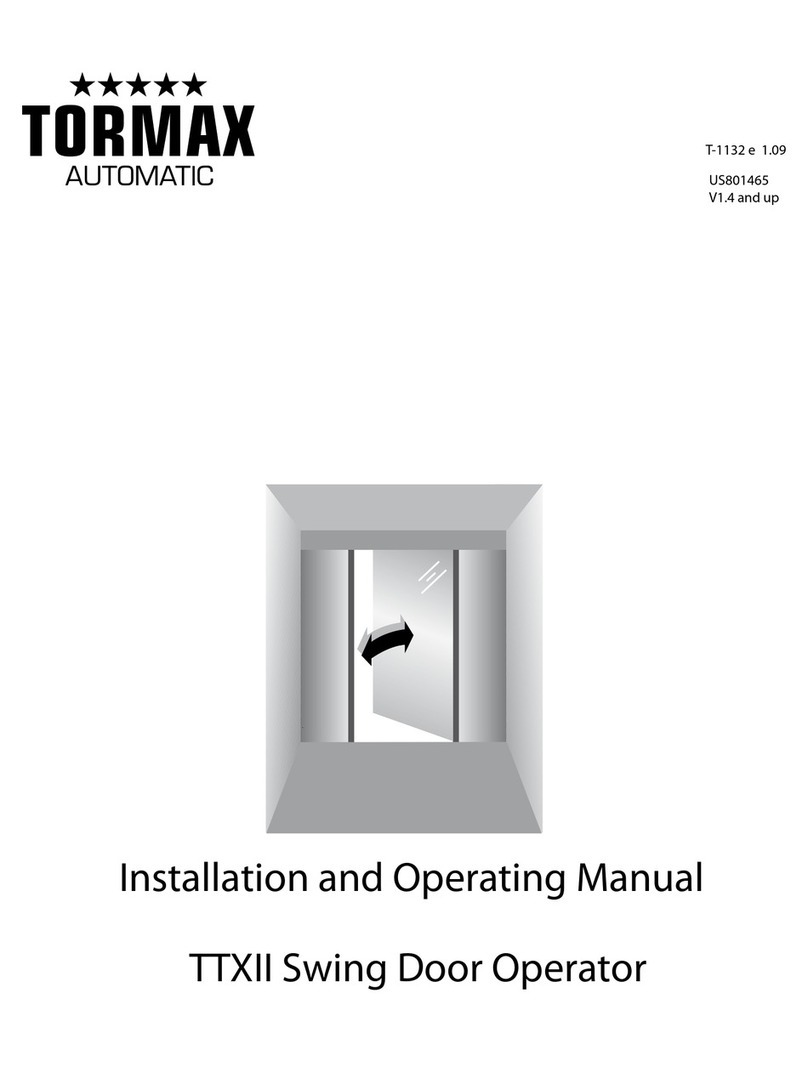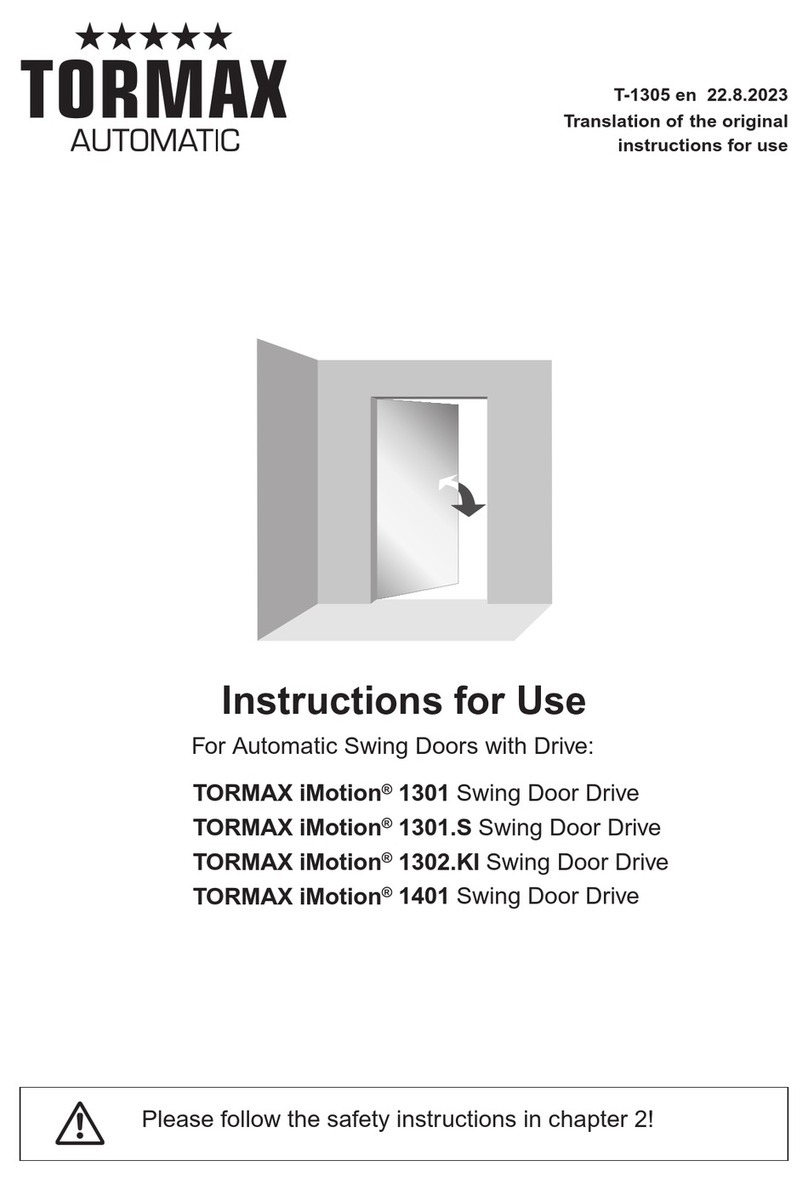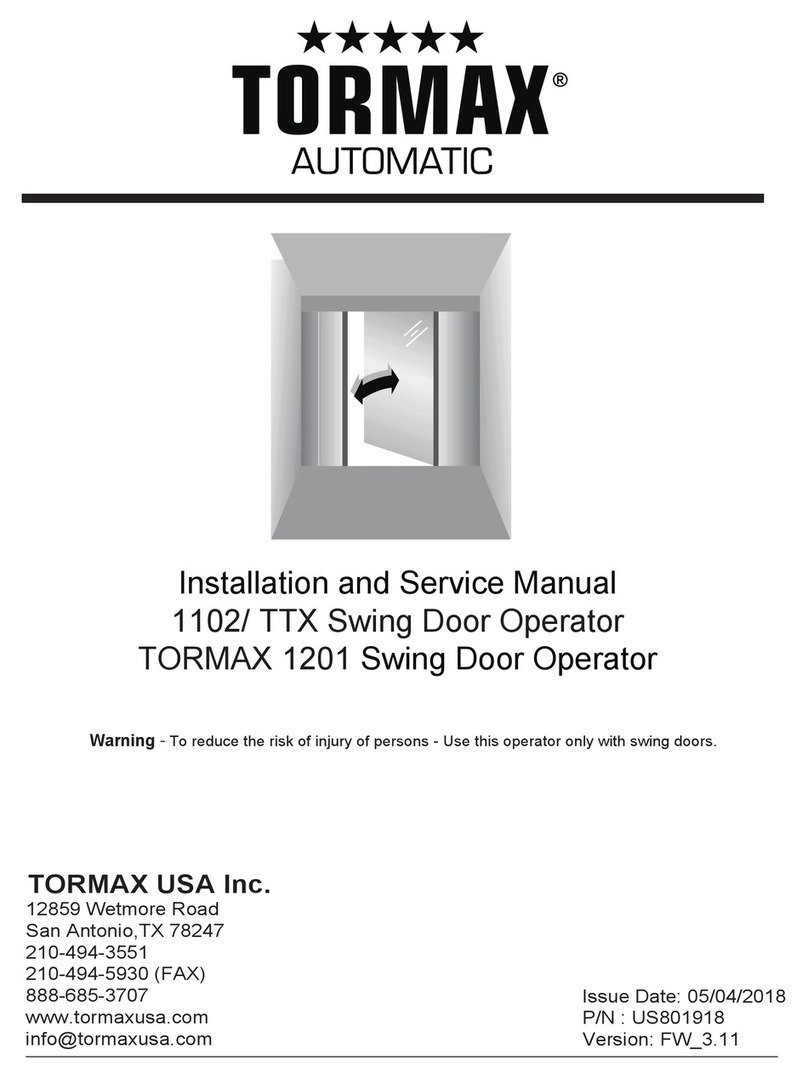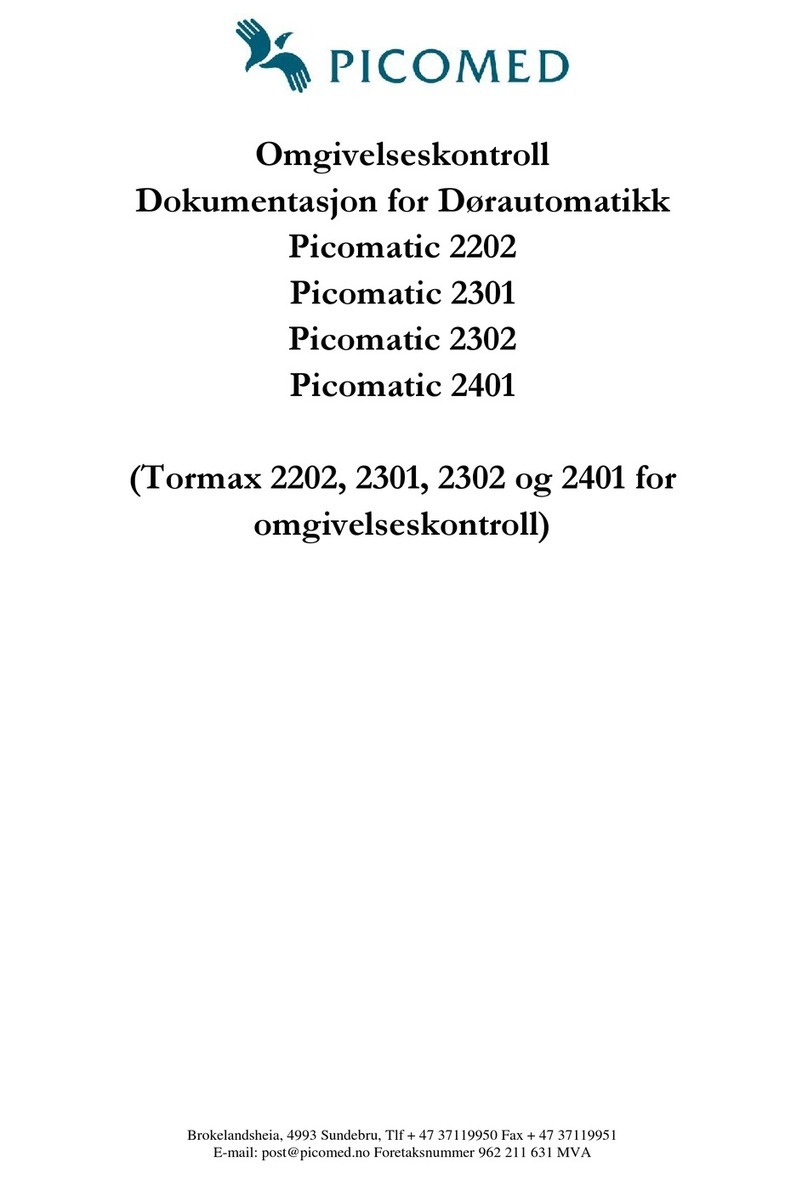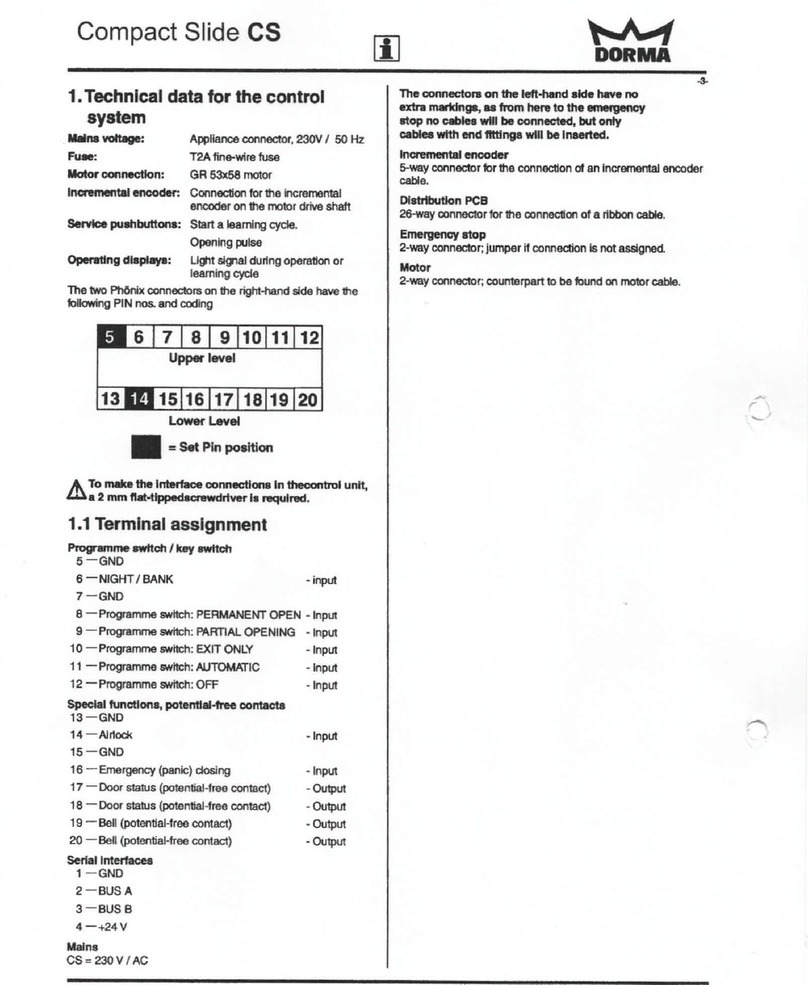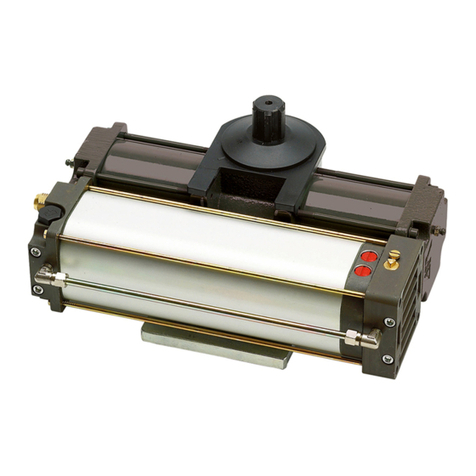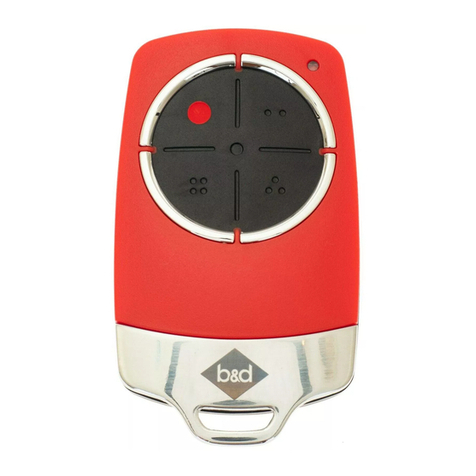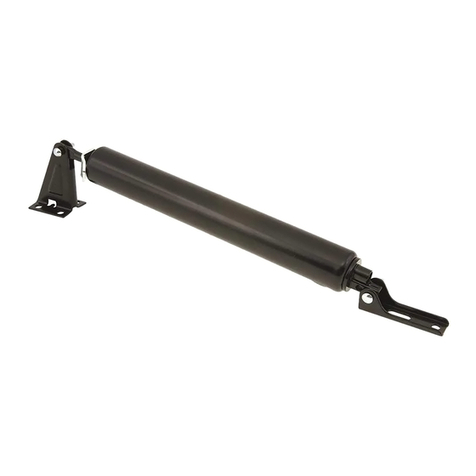Tormax iMotion 1301 User manual

T-1305 e 17.2.12
Translation of the original
instructions for use
Instructions for Use
For Automatic Swing Doors with Drive
iMotion®1301 Swing Door Drive
iMotion®1301.S Swing Door Drive
iMotion®1401 Swing Door Drive

2Instructions for Use iMotion 1301/1301.S /1401 T-1305 e
Table of Contents
1 General Information 3
2 Safety 4
2.1 Responsibilities 4
2.2 Use for the Purpose Intended 4
2.3 Pre-Conditions for the Operation of the System 4
2.4 Hazards and Risks 4
2.5 Checks 5
2.6 Decommissioning the System in the Event of a Fault 5
2.7 Disposal 5
3 Product Description 6
3.1 System Overview 6
3.2 System Function 7
3.3 Operating Modes 8
4 Operation 9
4.1 Commissioning 9
4.2 Operation with the TORMAX User Interface 9
4.3 Operation with an Operating Mode Switch 10
4.4 Operation on Power Failure 10
4.5 Resetting the Panic Fitting 10
5 Procedure in the Event of a Fault 11
6 Maintenance 12
6.1 Cleaning 12
6.2 Functional Checks 12
6.3 Maintenance and Testing 12
7 Appendix 13
7.1 Fault Table 13
7.2 Check-List for Functional Checks 14
Declaration of Conformity 15
First edition: 2.12.11, update: 2.12
We reserve the right to make technical changes.
Printed on environmentally friendly paper bleached without the use of chlorine.
Landert Motoren AG and Landert GmbH are certified to ISO 9001.

Instructions for Use iMotion 1301/1301.S /1401 T-1305 e 3
1 General Information
Target Groups
• Operatoroftheautomaticswingdoor.Theoperatoristhepersonresponsiblefortheoperationand
maintenance of the system.
• Personsinstructedbytheoperatortocarryoutcertainduties,forexampletheservicingandmaintenance
of the automatic swing door.
Area of Application
Product name, door system: Automatic swing door
Product name, door drive: iMotion®1301 Swing Door Drive
iMotion®1301.S Swing Door Drive
iMotion®1401 Swing Door Drive
Serial number: ………………………………………
Identification plate
(example)
These Instructions for Use apply to all the above door drives (see the “Technical Data” section for differ-
ences).
Explanation of the Symbols
The warning message warns about possible risk of injury.
Text which is highlighted in grey MUST be observed to ensure that the system operates perfectly.
Failure to observe these sections can cause damage to equipment.
Functions marked with this symbol are the factory setting. However, they can be reprogrammed
by a skilled person.
Optional components which are not present in all systems.
<
The identification plate with the
serial number is placed in the
controlbox(1401)oronthedrive
itself under the casing (1301,
1301.S).
Technical Data iMotion 1301 iMotion 1301.S iMotion 1401
Drive type Electromechanical swing door operator with AC permanent magnet synchronous motor
Control system iMotion MCU32
Mains connection 1x230/1x115VAC,50–60Hz,10A
Power consumption 6 … 250 W 12 … 330 W 4 … 250 W
Power supply 24VDC+0,5/–1,5V,max.18W*/0,75A,
in battery operationmin.16,5V
40VPWM/max.24W*/2A,equivalent
6…24VDC,voltageandfunctionpro-
grammable. Only for inductive or resis-
tive loads without overload protection.
*Totalload30W
24VDC+0,5/–1,5V,max.36W*/1,5A,
n battery operationmin.16,5V
40VPWM/max.24W*/2A,equivalent
6…24VDC,voltageandfunctionprogram-
mable. Only for inductive or resistive loads
without overload protection.
*Totalloadmax.50W
Protective class, drive IP22 IP22 IP 67 (7 days water
up to upper edge of
oorbox)
Protectiveclass,controlbox – – IP 55
Ambient temperature –20°Cto+50°C
Noise emission level <70db(A)

4Instructions for Use iMotion 1301/1301.S /1401 T-1305 e
2 Safety
2.1 Responsibilities
For instructing the operator: A skilled person from a TORMAX sales partner
For operating the system: The operator or a person instructed by the operator
For maintenance and function control: The operator or a person instructed by the operator
For annual testing and approval: A skilled person authorised by the manufacturer
Skilled persons are persons who have adequate knowledge in the field of power-operated doors as a
result of their specialist training and experience and who are so familiar with the relevant health and
safety regulations, guide-lines and generally recognised codes of practice that they are able to assess the
condition of power-operated doors with regard to the safety of their operation.
Maintenance of electrical parts must be carried out by a trained electrician.
2.2 Use for the Purpose Intended
Theautomaticswingdoorisintendedexclusivelyforuseindrypremisesinareasusedasapedestrian
thoroughfare. Special techniques can also be used to attach the drive unit to the building envelope. The
manufacturer will not accept any liability whatsoever for loss or damage caused by improper use, failure
tocomplywiththemaintenancespecication(seesection6)orunauthorisedmodicationofthesystem.
2.3 Pre-Conditions for the Operation of the System
The door system was designed, installed and checked for functionality and safety by skilled persons prior
to hand-over to the operator. The company responsible for the system’s installation instructed the operator
on the system’s use and maintenance as well dangers associated with the system operation. The opera-
tor has confirmed this by his signature in the system test book T-879.
The provisions imposed by law, health and safety and occupational health regulations for the avoidance
of accidents and the protection of the environment which are generally applicable in the country in which
the system is operated supplement the Instructions for Use.
• ReadtheInstructionsforUsecarefullybeforecommissioningtheautomaticswingdoor.
• Onlyusethesystemwhenitisinperfectworkingorder.Theoperatingconditions,inspectionand
maintenanceintervalsstipulatedbythemanufacturermustbeobserved(section6).
• Safetyfacilities(e.g.sensortechnology,protectingcovers)mustnotberemovedordisabled.
• Arrangetohaveanyfaultsrectiedimmediatelybyaskilledperson.
2.4 Hazards and Risks
Depending on the system design and equipment, there is a residual risk of crushing, shearing and collision
with limited force in the movement area of the door leaf.
iMotion 1401 iMotion 1301, 1301.S

Instructions for Use iMotion 1301/1301.S /1401 T-1305 e 5
Hazards can arise:
– intheregionofallclosingedges(particularlyclosetothehinge)
– intheregionofthelinkagelever
– if,forexample,salesstandsareerectedindirectproximitytotheoperatingrangeofthedoorleaves
– duetodeliberatedamagebyvandals,defectivesensorsorsensorswhicharenolongerproperlyad-
justed, sharp edges, incorrectly supported and defective casing or missing covers.
2.5 Checks
TheregularchecksandexaminationssetoutinChapter6mustbecarriedoutasinstructedbythemanu-
facturer. The manufacturer recommends that a maintenance contract be concluded in order to operate the
system safely and to maintain its value for as long as possible.
2.6 Decommissioning the System in the Event of a Fault
If there is a fault the automatic swing door may only be taken out of service by a skilled person, the op-
erator or a person who is instructed to do so by the operator. This must be done on all occasions on which
the safety of persons could be compromised.
• Disconnectthesystemfromthepowersupply.
• Selectoperatingmode“P”ifthesystemcontinuestooperateusingtheinternalemergencypowersup-
ply(seesection3.3foroperatingmodes).
• Openthedoormanuallyandsecureintheopenpositionifitisinstalledinanescaperoute.
• Firedoorsmustneverbesecuredintheopenpositioneveninemergencies.
See section 7 for rectification of faults.
2.7 Disposal
This system must be properly dismantled at the end of its working life. Its disposal must comply with na-
tional regulations. We recommend that you contact a skilled person disposal company.
– Aggressiveacids.
– Riskofinjuryifyoudismantlethebatterymodule.
– Disposeofbatteriesproperly.
– Flyingaroundparts.
– Thetensionedspringrepresentsa
hazard when dismantling the drive.
– Beforeopeningthecasing,release
the tension on the spring up to the
stop as indicated in the drawing
(iMotion1301/1301.S:W=0)
– Brokenglass.
– Riskofinjurywhendismantlingthedoorleaves.
– Takecarewhentransportingthedoorleaves.
T1305_2
T1305_1
W
W

6Instructions for Use iMotion 1301/1301.S /1401 T-1305 e
3 Product Description
3.1 System Overview
1 Drive a)Motorandspringunit
b)MCU32controlsystemwithmonitoringsystem,powerlimitationand
permanent diagnosis.
£Controlled closing function of the door in power-off condition
£Controlled opening function in power-off condition
c)Linkage/slidinglever(1301)
c)£Pullarm(1401)
2Drive accessories ua)£Emergency power supply via the battery unit
£Mechanical closing sequence controller for double-leaf doors
£…
3 Door leaves a)Swingleafwithmainclosingedge(HK)andsecondaryclosingedge(NK)
b)£Finger protection to enhance the safety of the secondary closing edge.
4Operating controls a)£iMotion user interface with 6 operating modes and fault display
b)£Operating mode switch with 3 positions.
c)£Lock for the user interface
d)£Remote control of operating modes
5Internal activators a)Withautomaticactivation b)Withmanualactivation
£Radar with/without direction recognition £Push button
£IR motion detector £Contact-free button
£Contact mat £…
6External activators a)Withautomaticactivation b)With manual activation
£Radar with/without direction recognition £Key switch
£IR motion detector £Card reader
£Contact mat £Remote control
£… £…
7Safety sensors a)£Presence sensor safeguarding the swing area when closing
b)£Presence sensor safeguarding the swing area when opening
c)£Presence sensor safeguarding theopposingclosingedge(GK)
d)£Presence sensor: secondary closing edge protection
£…
8Emergency systems a)£Power switch / fuse
b)£Emergency on/off switch
c)£Fire alarm system
9Output message £Bell/gong
£Light
£Door status
10 Lock ua)£Electrical door opener
b)£Door handle
c)£Mechanical door lock
£Depending on the system’s equipment
8c
HK
HK
inside outside
NK GK
GK
5a
7b
6a
6b
1b
1a
2a,
4d
3a
10b,c
4a 4b 4c
5b 8b
4a 4b
10a
8a 7a
7d 7c
3b
3b
T1305_6e
7a
5a
HK
inside
iMotion 1301, 1301.S iMotion 1401
GK
1a,b 2a
3
1c
10b,c
4a 4b 4c
5b 8b
4a
4b
4d
8a 8c 9
1a
1c

Instructions for Use iMotion 1301/1301.S /1401 T-1305 e 7
3.2 System Function
The operator of the door system is responsible for ensur-
ing that the automatic swing door is freely accessible at
all times. The operator must particularly ensure that the
swing area of the door leaves is not obstructed by any
objects.
Automatic Door Operation with Sensors
Whenoperatingautomatically(AUTOMATICoperatingmode)thedoorisautomaticallyopenedfromboth
sides by sensors when a person approaches.
A key switch uor card reader unormally allows access from outside when the door is in operating mode
EXIT or OFF. The door unlocks, opens and closes again as soon as no further sensors are activated after
a hold-open time which is set separately.
The sensors for the door opening and the maintained opening of the door are arranged and adjusted in
such a way that the door opens promptly and remains open as long as a person is within the operating
rangeofthedoorleaf.Thedoorcancloseneverthelessbutonlyafteratimeofapprox.>1minute.
The reduced closing speed which is set by the installer and is adjusted in line with the door weight, com-
bined with a force of < 150 N prevents the impact of the moving leaves on a person from being too severe.
The obstruction is also detected by the control system and the door automatically reverses.
Safety sensors are necessary and depend on the design of the door system (distances, speeds, forces
appliedbythedoor).When a person moves into the danger area, the door leaf stops or slows down to a
very low speed depending upon the settings performed by the fitter at the time of commissioning.
Semi-automatic Operation with “Push-and-Go”
Instead of having sensors the door can be manually pushed open. After being detected by the control
system, the door opens automatically and closes again.
Traffic Control
Movement throughthedoorcanbeallowedin only onedirectionifdesired(operating mode EXIT) or
completelyblocked(operatingmodeOFF).
If there is a high level of pedestrian traffic or if the door is to be used by infirm or frail persons, the door
can be switched to operate in operating mode AUTOMAT 2 with a longer hold-open time.
Automatic System Monitoring
The control system monitors the safety sensors by a cycle of active tests. The control system also conducts
continuous internal system tests. If a safety-related component should fail, the system automatically
switches into a safe condition. At the same time the fault number is displayed on the user interface. You
can find further information on this subject in section 5 “Procedure in the Event of a Fault”.
Electric Lock u
The system can be locked in the closed position by means of an electric lock u.
Operation in the Event of a Power Failure
Depending on the equipment installed, the following functions are possible:
– Controlled closing using the integral spring. The door can be opened manually by means of the door
handle(unlocking).
The door then closes again in a controlled manner using the integral spring.
– Controlledopeningusingtheintegralspring.Thedoorremainsopen.
T1540_12

8Instructions for Use iMotion 1301/1301.S /1401 T-1305 e
– Continuedoperationforacertainperiodinthecurrentoperatingmodebymeansofabatteryunitu.
– Unlockingandopeningof thedoorfromoutsidebymeansofakeyswitchandthebatteryunitu.
3.3 Operating Modes
The automatic door system can be operated with the TORMAX user interface u(6 operating modes and
statusdisplay)orwithanoperatingmodeswitchu(3operatingmodes).
Operating Mode OFF
Theinternalandexternalsensorsaredisregarded.Thedoorismechanicallyheldintheclosedposition
and locked using an electric lock u. Access is only possible using the key switch or if the door is manu-
ally unlocked using a key or the door handle is used to open the door manually.
<The door can still be used for 5 seconds after selecting operating mode OFF. The door then locks at
the end of this period as soon as it is closed. The transition is signalled on the user interface by the flash-
ing display of operating mode OFF.
Operating Mode AUTOMATIC 1
The operating mode AUTOMATIC 1 is normally used during the day. The door opens automatically through
the inside and outside sensors. The door can behave differently depending on the settings programmed
during commissioning:
“Push-and-Go”
If the door is manually pushed in the opening direction, it reacts as if to a command to open: it opens
automatically, waits for the hold-open time and then closes.
Systems with an Electric Door Lock u
The lock unlocks on every valid opening impulse. The door lock must be manually unlocked with the door
handle before it is possible to open the door with the “Push- and-Go” system. In this operating mode the
door lock can also be permanently unlocked depending on the setting programmed at the time of com-
missioning.
Operating Mode AUTOMATIC 2
Corresponds to operating mode AUTOMATIC 1 but a different motional sequence can be set during com-
missioning(e.g.asloweropeningmovement,differentopenpositionsandalongerhold-opentime).
Operating Mode EXIT
Operating mode EXIT is normally used for the period before the shop or office closes. The door will only
openautomaticallywhenactivatedbytheinternalsensor.Whenthedooropenstheexternalsensoris
also monitored for safety reasons. The open position is determined by the preceding selection of the op-
erating mode AUTOMATIC 1 or AUTOMATIC 2. Additionally the door can be locked automatically by the
door lock u.The door lock can be permanently unlocked in this operating mode in case of need.
Operating Mode OPEN
The door opens and remains open. The open position is determined by the preceding selection of the
operatingmodeAUTOMATIC1orAUTOMATIC2.Thedooropensagainonreceivingthenextopenimpulse
or when changing the operating mode to OFF and back again to OPEN.
Operating Mode Manual Operation
The door leaf can be freely moved. This operating mode can be used for cleaning the door leaf or for
temporarily shutting down the door. The system is reset after leaving this operating mode.
In this operating mode the door lock can also be permanently unlocked depending on the setting pro-
grammed at the time of commissioning.
P

Instructions for Use iMotion 1301/1301.S /1401 T-1305 e 9
4 Operation
The automatic swing door may only be operated by a skilled person, the operator or a person instructed
by the operator.
4.1 Commissioning
Beforeswitchingonthemainspowersupply:
• Unlocktheoptionalmechanicaldoorlock.
• Checkthatthemovementareaof thedoorleavesisfreefromobstructionssuchasracks,plantcontain-
ers, umbrella stands etc.
• SwitchonthemainspowersupplyandselectoperatingmodeAUTOMATIC1,forexample.
The first movement after switching the power on for the first time is slow and H62 and H67 are dis-
played.Thecontrolsystemisdeningtheclosedpositionof thedoorleaf (H62)andischeckingthe
doorleaftraveldistance(H67).
The door is now ready for operation.
4.2 Operation with the TORMAX User Interface u
TORMAX User Interface uLock ufor User Interface
Selection of Operating Modes
• Releaselockufor user interface.
• Pressselectorkeys1or2briey.Thecorrespondingoperatingmodesymbolisilluminated.
Fault Display
E.g. H91 or E42 See section 7 for the meaning of the display.
• Resetbypressingtheselectorkey2briey.
Resetting the System
• Presstheselectorkey2foratleast5seconds.
The software is restarted. The control system then conducts a calibration run, checks the travel distance
and looks for the closed position. Displayed as H62 and H67.
www.tormax.com
1
2
3
4
1
1
0
T1427_4
T1321_1e
OFF
AUTOMATIC 1
AUTOMATIC 2
OPEN
EXIT
Operating mode
symbols
Manual operation
Door electrically
locked
Selector key 2,
downwards
Selector key 1,
upwards

10 Instructions for Use iMotion 1301/1301.S /1401 T-1305 e
4.3 Operation with an Operating Mode Switch u
Selection of Operating Modes
The switch position defines the operating mode.
T1305_4
OFF
AUTOMATIC 1
OPEN
Resetting the system
– Changetheoperatingmodeintheeventof afault
or
– Cutoffpowersupplytothesystemforatleast5seconds.
4.4 Operation on Power Failure
Opening a Door using a Key Switch uwith aBattery Unit u
• Turnthekeyswitchtothe“on”positionandholdinplaceforatleast5seconds,thenturnthekeyto
the original position.
The battery is activated using the “wake up” function.
The key switch must not remain permanently in the “on” opposition.
The door is unlocked and opened.
The battery switches off again after the time programmed <by the installation engineer or
when the battery is fully discharged.
If required, the operating mode can be changed on the user interface during the wake-up.
4.5 Resetting the Panic Fitting u
• SelectoperatingmodeOFF(operatingmodeswitch, user interface )ordisconnecttheoperator
frommains(installationswitch,mainsplug).
• Pushthedoorleafbackintotheinitialposition.
• ChooseoperatingmodeAUTOMATIC1orswitchonoperator.

Instructions for Use iMotion 1301/1301.S /1401 T-1305 e 11
5 Procedure in the Event of a Fault
Faults are evident from abnormal door behaviour and/or as a fault display on the user interface. Fault
displays on the user interface take the form of a flashing “E” or “H” followed by two figures.
H=notication>thesystemcancontinuetobeused.
E=fault>thesystemisstationary.
Some faults or notifications can be rectified by restarting the door drive with a software reset and/or
briefly disconnecting the system from the power supply.
Fault Display and Reset Using the TORMAX User Interface
See the table in section 7.1 for an overview of the fault displays.
Browsethroughthefaultdisplayusingselectorkey1upwards
(todisplayseveralfaults).
1. Reset the faultdisplay,pressselectorkey2(downwards)briey.
2. Software reset: press the key for 5 seconds.
Reset of the Fault with the Operating Mode Switch
Software reset in the event of a fault: change the operating mode.
Reset of the Fault by Disconnecting the Power Supply
If the system does not have a battery unit, disconnect from the power supply for about 10 seconds.
If this does not reset the fault or if it re-occurs after a short time, you must arrange for the fault to be rec-
tified by a skilled person from your TORMAX dealer. In this case note the fault number and inform the
dealer. See the last page or the service tag on the system for the dealer’s address.
T1305_5
T1305_4

12 Instructions for Use iMotion 1301/1301.S /1401 T-1305 e
6 Maintenance
The system was tested and approved by a skilled person before initial commissioning. The manufacturer
recommends that you conclude a service contract in order to maintain the value of your system for as long
as possible as well as to ensure the system operates reliably and safely for a long time.
Only genuine TORMAX spare part should be used. The manufacturer accepts no liability if you fail to
observe this requirement.
The following maintenance work must be carried out:
6.1 Cleaning
– Closingdoorscancrush–danger!
– Trappedlimbscanleadtoseriousinjury.
– ThesystemmustonlybecleanedinoperatingmodeOFF,OPENorManualOperation.
• Cleanthecontrolbox,userinterface,thecoversanddoorleaveswithadampclothandacommercial
cleaning agent.
6.2 Functional Checks
The operator must check the function and safety devices of the automatic swing door at least every
three months. This will ensure that faults or hazardous changes in the system are detected at an
early stage. See section 7.2 “Check-list for Functional Checks” for items to be checked.
You should arrange for any defects detected during the routine checks to be rectified immediately by a
TORMAXdealer(seethelastpageofthisManualfortheaddress).
– Possiblemalfunctionof theautomaticswingdoor.
– Potentialhazards–injurycausedbyimpactorcrushing.
– Donotuseanypartofyourbodyforfunctionalchecks.Useasuitableobject(e.g.styro-
foamorcardboard)instead.
6.3 Maintenance and Testing
Maintenance and testing should only be carried out by a trained skilled person following the manufacturer’s
instructions.
Maintenance Interval
The maintenance interval depends on the frequency of use but the system must be maintained at least
once per year.
Scope of the Maintenance Work
The content of the maintenance work is specified by the manufacturer in an inspection list.
System Test Book
The test findings are recorded after the test in the system test book. The operator must keep it in a safe
place.

Instructions for Use iMotion 1301/1301.S /1401 T-1305 e 13
7 Appendix
7.1 Fault Table
System Behaviour No. Cause Remedy/ Rectification
The door stops when
opening.
H91 Electronic obstacle recognition
caused by persons, wind pressure
and ventilation when opening.
Remove the obstruction.
Avoid drafts.
Door reverses when
closing.
H92 Electronic obstacle recognition
caused by persons, wind pressure
and ventilation when closing.
Remove the obstruction.
Avoid drafts.
The door stops repeat-
edly when opening.
H93 Electronic obstacle recognition on
opening in the same position by sta-
tionary obstacle.
Remove the obstruction.
The door stops repeat-
edly when closing.
H94 Electronic obstacle recognition on
closing in the same position by sta-
tionary obstacle.
Remove the obstruction.
Search run notified. H62
H67
Search run of the door after a reset or
after power recovery.
Allow the search run to travel its full
course.
Door operates at a re-
duced speed.
H71 Batteryoperation Wait for power recovery
Switch on mains supply.
Door remains closed. – Operating mode for example OFF,
EXIT or P. The door is prevented from
moving by the lock.
E.g. select operating mode AUTO-
MATIC 1. Unlock the lock. Push the
door closed briefly.
Door remains open. – OperatingmodeforexampleOPENor
P. The door is prevented from moving
by the lock.
E.g. select operating mode AUTO-
MATIC 1. Remove the obstruction.
The door remains
closed.
E31 The safety facility in the opening direc-
tionispermanentlyactive(>1minute)
or defective.
Remove objects from within the
rangeofthesensor(s).
The door remains open E32 The safety facility in the closing direc-
tionispermanentlyactive(>1minute)
or defective.
Remove objects from within the
rangeofthesensor(s).
The door does not open
or does not close.
E33 The safety facility for the swing area is
permanentlyactive(>1minute)orde-
fective.
Remove objects from within the
rangeofthesensor(s).
The door does not open
or does not close.
E34 The stop safety facility is permanently
active(>1minute)ordefective.
Remove objects from within the
rangeofthesensor(s).
The door remains open. E41
E42
E43
Activatorinsideisactive>1min.
Activatoroutsideisactive>1min.
Keyswitchisactive>1min.
Get sensor adjusted by a skilled
person.
Reset the key switch.
The door stands still E5.. Anomaly in the travel distance.
Solid obstruction in the movement
area.
Remove firm obstacle in the travel-
ling range of the door.
Perform a software-reset.
The door stands still E61
E62
Power supply is overloaded or voltage
too low.
Get the power supply and connec-
tions checked by a skilled person.
The door stands still E64
E65
Drive/control system is overheated. Wait for the automatic reset after
the door/control system has
cooled.
Protect from direct sunlight.
The door stands still. E..
E8..
Control system shut down for safety
reasons.
Perform a software-reset.
The door collides with
people.
–Safety device or setting inadequate. Shut down the system.
(seesection2.6).

14 Instructions for Use iMotion 1301/1301.S /1401 T-1305 e
7.2 Check-List for Functional Checks
Item To Be Checked Procedure Result
Sensors
T1540_5
• Walkthroughthedoordirectlyfrom
the front and from different direc-
tions at normal speed, starting both
from the inside and outside.
The door opens at the right time
and with sufficient speed so that
passage through the door Is not
hindered.
Safety Sensors
T1540_6
• Walkthroughthedoordirectlyfrom
the front and from different direc-
tions at a slow speed like an infirm
person, starting both from the inside
and outside.
The door opens and remains
open until you are completely
through the door.
Swing Leaf, Door Frame
T1540_10
• Checktheglassdoorllings,door
edges and rubber profiles for dam-
age.
The door fillings have no sharp
edges and splintered glass.
The side parts and the door seals
are in place and undamaged.
Panic Fitting u
T1540_9
• Isolatethedrivefromthepowersup-
ply(mainsystemswitch,mainsplug)
or select operating mode OFF. Then
push the door in the direction opposite
to the opening direction until the pan-
ic fitting releases the door leaf. Now
push the door leaf back to the initial
position.
The panic fitting can be released
and returned to the initial position.
Drive, Lever and Hinges
T1540_8
iMotion 1401 iMotion 1301, 1301.S
• Checkthenoisesmadewhilethe
door moves.
No unusual and noticeable noise
can be heard from the drive, the
lever or in the region of the hinges.
No significant wear is visible.
Operating components, lettering and marking
3
• Check the function and marking of
operating controls. Check all lettering
and marking for their condition.
The operating controls are func-
tioning correctly; the markings are
visible and legible.
System Vicinity
T1540_7
• Check access to the door and the
movement area of the door leaves.
Access to the door is free from
objects and items likely to cause
the user to trip. There are no ob-
jects such as shelves, plant con-
tainers and umbrella stands
within a radius of 50 cm of the
movement area.

Instructions for Use iMotion 1301/1301.S /1401 T-1305 e 15
Declaration of Conformity
In the sense of the guideline for machines 2006/42/EG, appendix II A
Product: Automatic Swing Door
Type designation: ❏iMotion 1301 ❏iMotion 1301.S ❏iMotion 1401
Serial number: .
Manufacturer’s address : .
Base documents: Declaration of incorporation by TORMAX | Landert Motoren AG with
the document number: T-1542
Additionally to the standards listed in the declaration of incorporation
this door installation is in conformity with the regulations listed
below:
DIN 18650-2
We declare in sole responsibility, that the above mentioned product, which is referred to by this
declaration, is in conformity with the guideline for machines 2006/42/EG (Declaration of
incorporation T-1542).
Furthermore, the guideline 2006 /95 / EG (low tension) and 2004 /108 / EG (electro-magnetic-
compatibility) must also be adhered to. This product is in conformity with the base documents
and standards listed above (Declaration of Conformity T-1309).
Place:
Date:
CE authorized person:

the passion to drive doors
TORMAX Sliding Door Drives
TORMAX Swing Door Drives
TORMAX Folding Door Drives
TORMAX Revolving Door Drives
Manufacturer: Advice, sales, installation,
repairs and service:
TORMAX |CH-8180Bülach-Zürich
Phone +41(0)448635111
Fax +41(0)448611474
Homepage www.tormax.com
E-Mail [email protected]
TORMAX is a Division and a registered trademark of Landert Motoren AG
415793
This manual suits for next models
2
Table of contents
Other Tormax Door Opening System manuals
Popular Door Opening System manuals by other brands
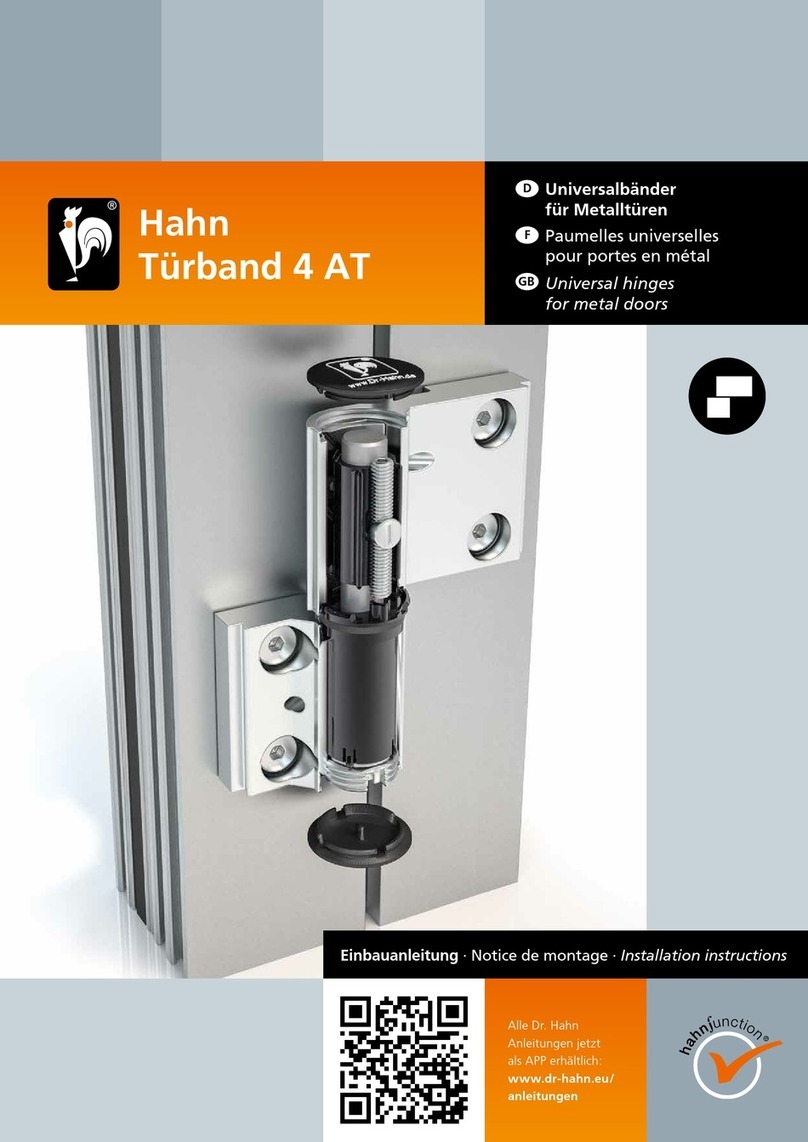
Dr. Hahn
Dr. Hahn Turband 3 installation instructions
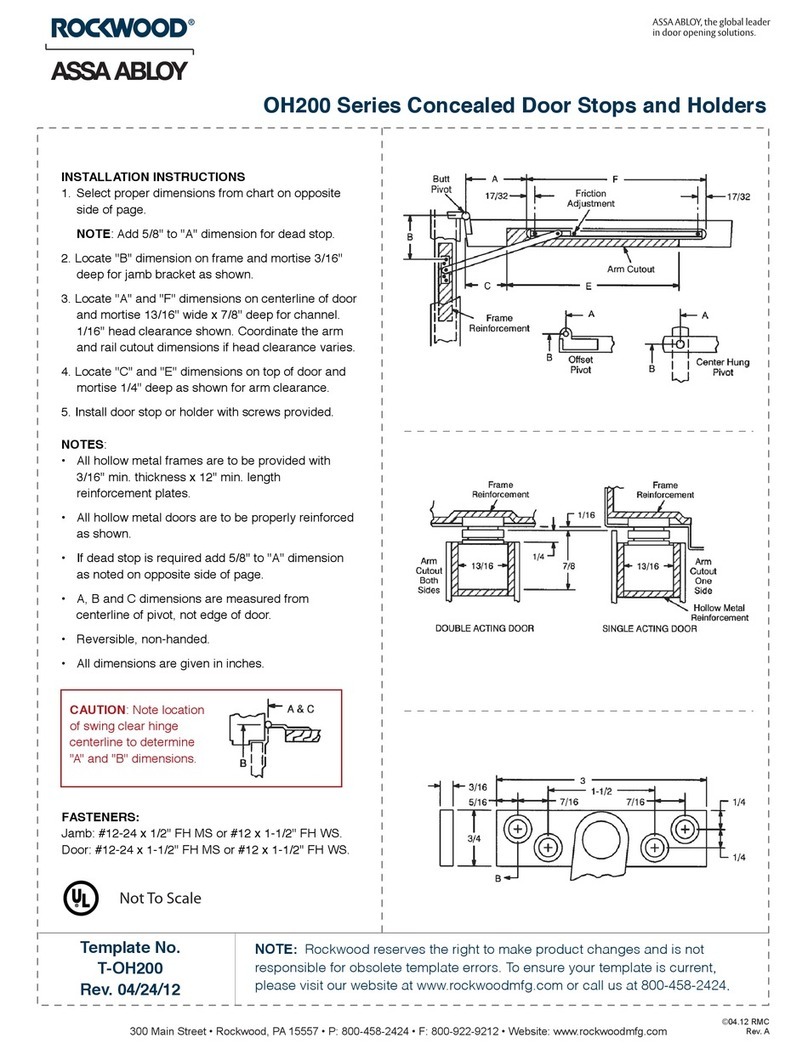
Assa Abloy
Assa Abloy Rockwood OH200 Series installation instructions
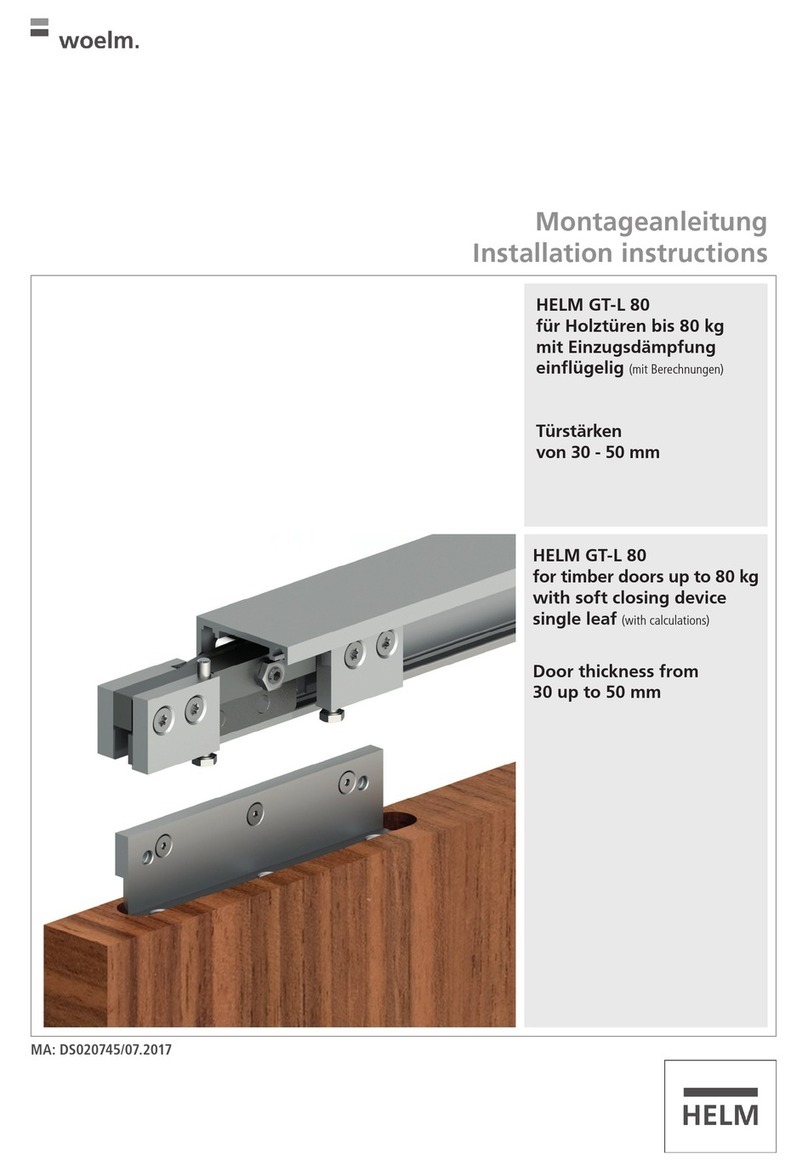
Woelm
Woelm HELM GT-L 80 installation instructions
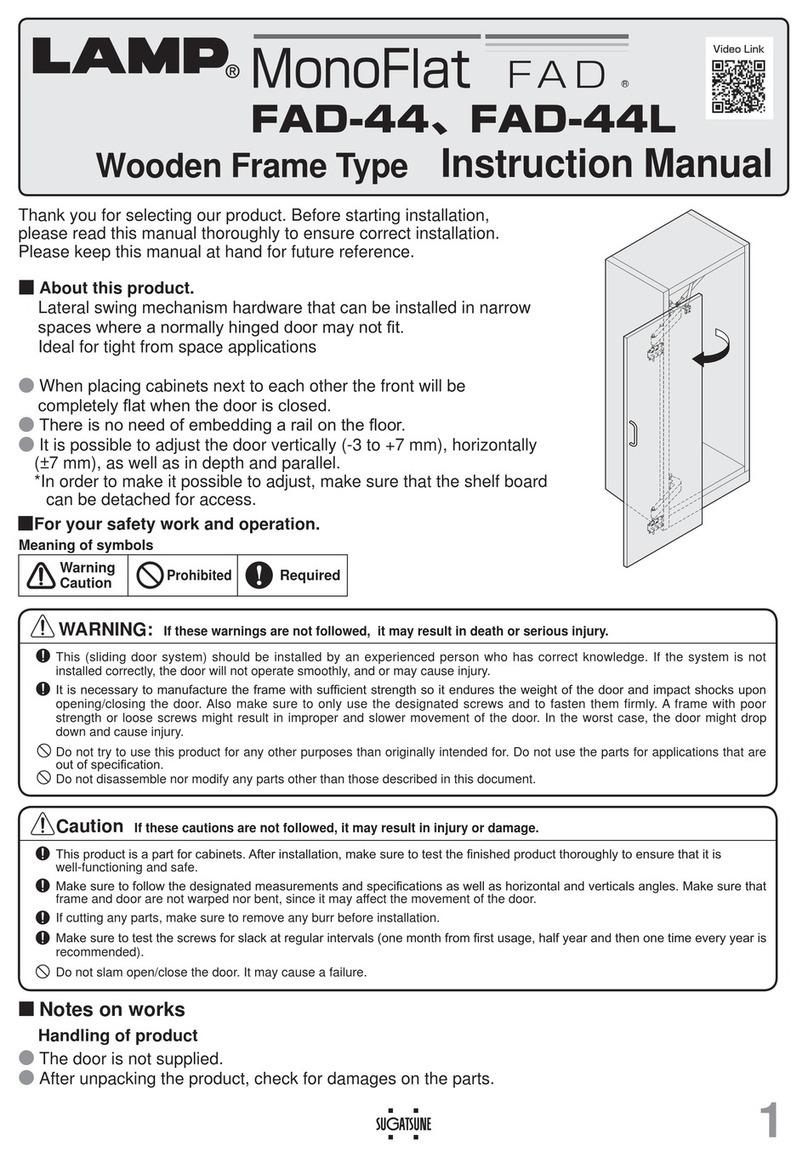
SUGATSUNE
SUGATSUNE LAMP MonoFlat FAD Series instruction manual
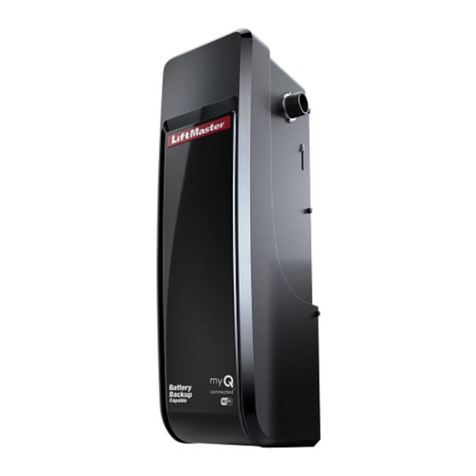
Chamberlain
Chamberlain DDO8900W manual
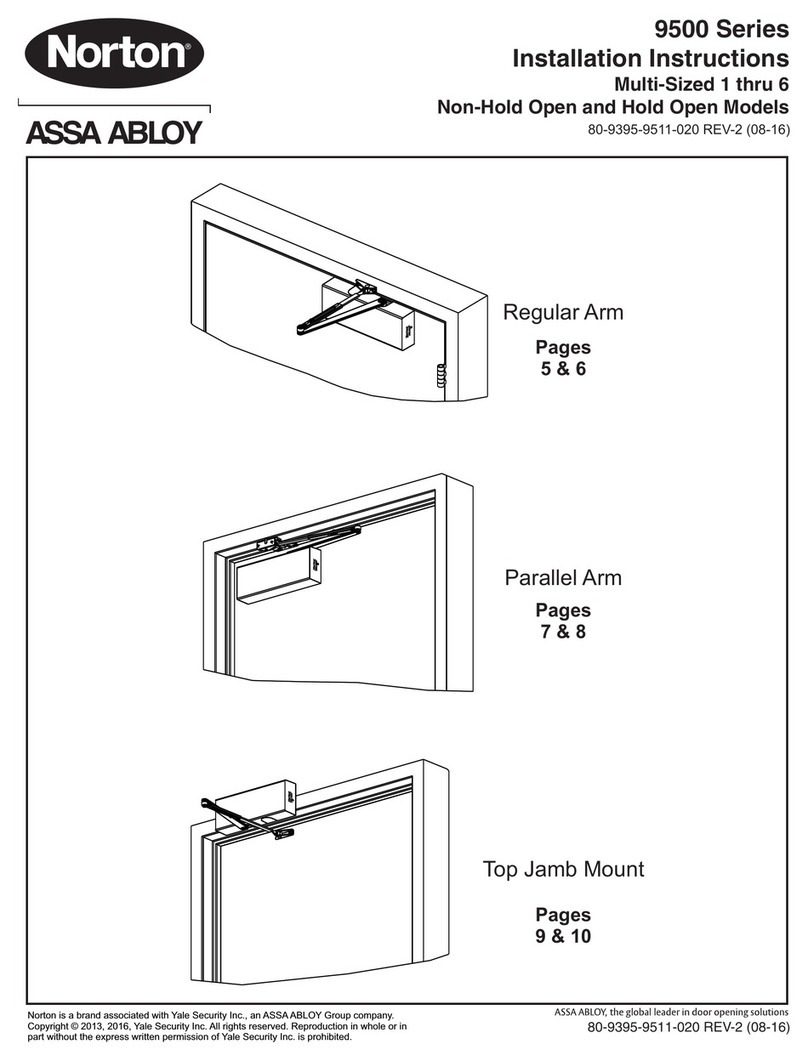
Assa Abloy
Assa Abloy Norton 9500 Series installation instructions

Dorex
Dorex 1701 Series installation instructions

Norton
Norton tri-style 1603BC installation instructions
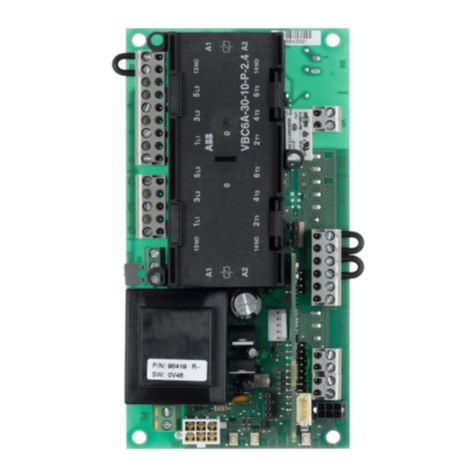
MFZ Ovitor
MFZ Ovitor CS 110 operating instructions

Beninca
Beninca JM.3 Operating instructions and spare parts catalogue
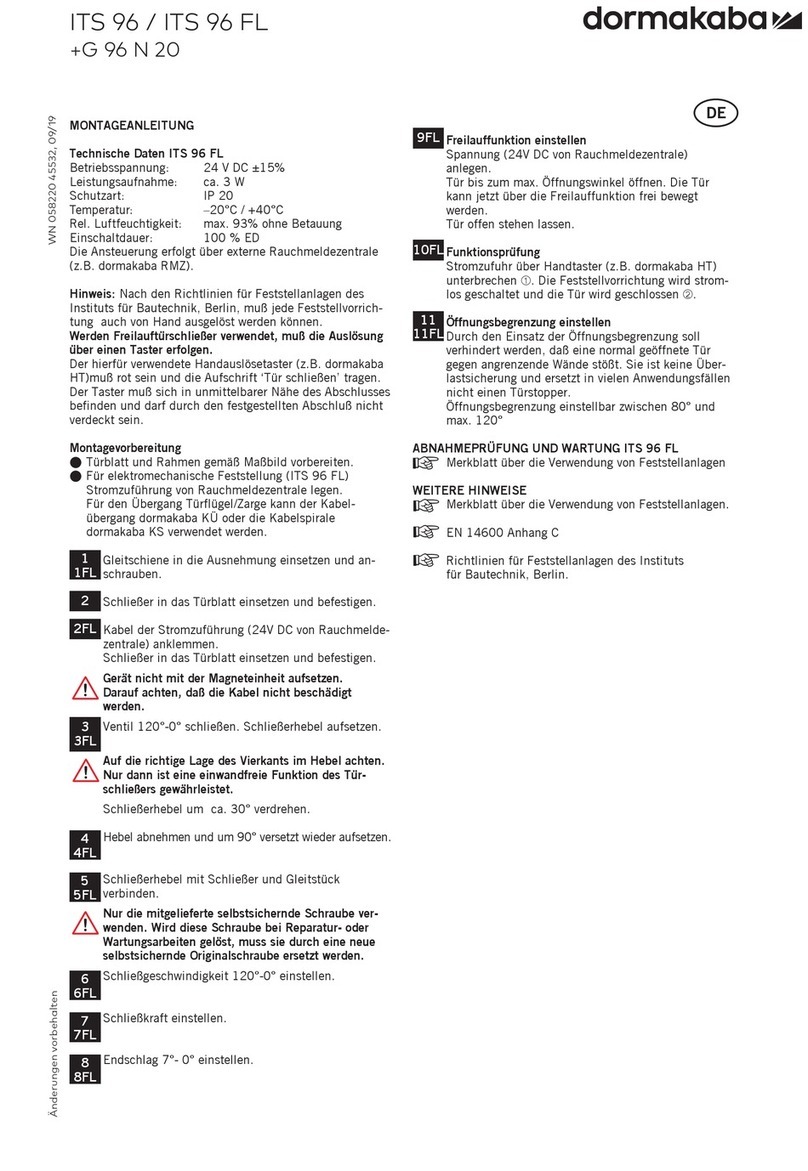
Dormakaba
Dormakaba ITS 96 Fixing instructions
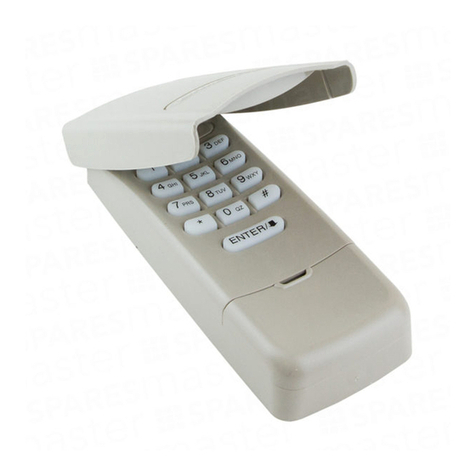
Chamberlain
Chamberlain 9747E Series Installation


